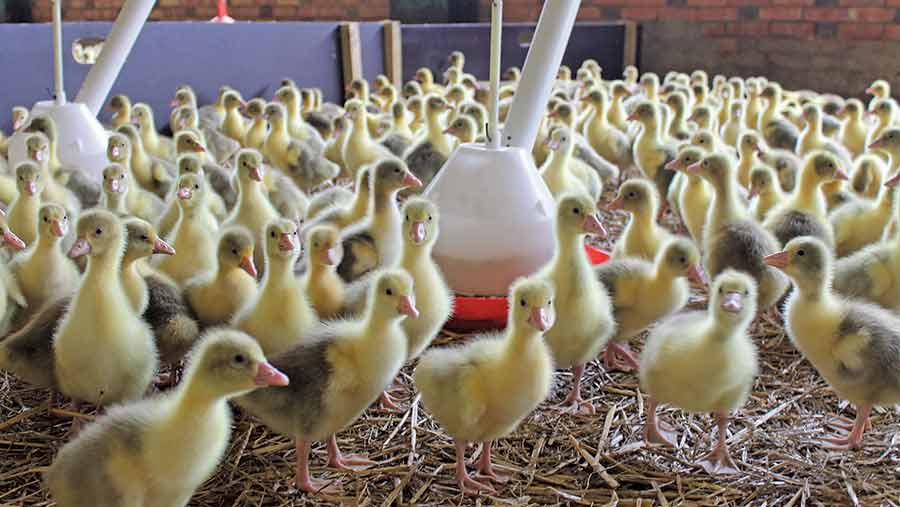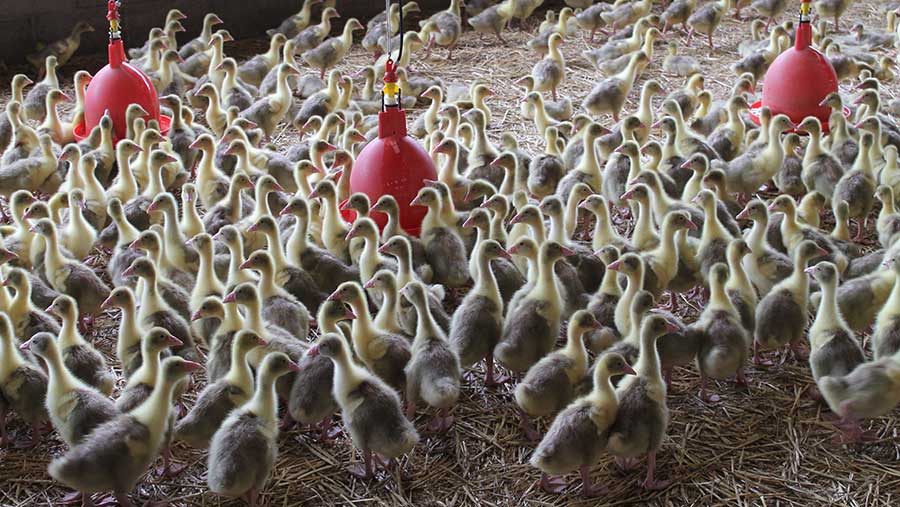Guide to successful gosling care

The first few days of a gosling’s life set the stage for its future performance, as Eddie Hegarty explains.
Building up a good rapport with your goslings is a crucial part of successful management, to ensure they become familiar with you and get the best start to life.
But it’s vital to prepare well before the goslings arrive, warming the concrete house floor before spreading the bedding.
During the first 10 days or so, the birds require constant warmth. The temperature under a gas brooder should be 32C and the house should not drop below 25C overnight, as lower temperatures now can cause unnecessary suffering.
Human contact
Once the goslings arrive, keeping a close eye on them is the key to success. Be prepared to visit them regularly over the first few days, being careful not to disturb them too much.
You need the goslings to become accustomed to your presence. Call to them, so they come to you, which will make it easier to spot any weaker birds.
When entering the building always introduce yourself first. Talk to them to avoid any unnecessary startling, and make sure the building is light enough so they can see you coming from a distance.
Some producers leave the lights on 24 hours a day for the first two weeks, reducing the risk of crowding and smothering if goslings are frightened by anything unusual.
When entering a building, always check that the environment is right by gauging bird behaviour:
- If the goslings are gathered together under the heater, they are too cold.
- If they are all around the outer fringes of the pen and gasping, they are too hot.
- If they gather in only one particular area, it is too draughty
- If the goslings are roaming around in and out from the heat source, then the conditions are perfect.
Indoor environment

With gas brooders, be aware they are using up the oxygen and giving off water vapour. If your goslings show signs of slow development, increase ventilation to the building. Relative humidity should be around 60-70%.
If the goslings have sweaty backs, the humidity is too high and you will need to increase ventilation; if not, this will promote pecking.
For the first few days you must refresh water and feed, and check temperature and humidity at least five times a day. Remove any dirty, wet litter and refresh.
Bird health
Keep a record of the number of birds introduced to the building, and a note of the number and date of mortalities. If mortality is above 2-4% over the first two to three weeks, contact your hatchery immediately and they will advise you if you need to contact a vet.
If there is high mortality through poor hatching or disease, this is what to look out for:
- Goslings that appear weak or are not very lively and droop their wings after a long journey will have used up their yolk sac. Examine their stomachs to see if it feels empty and the gosling is lightweight. If so, spray the goslings with a fine mist of water which is a fast and effective way to hydrate them.
- Goslings with bad stomachs and stunted growth may have an infected naval. These are usually graded out at the hatcheries, but some are only noticeable after two to three days. The cause is poor hatching.
- Any goslings with deformed limbs or curled-up toes are suffering from a vitamin B deficiency. Provide extra vitamins, calcium and minerals.
Increase pen size so goslings can start running to strengthen their legs and you will be able to notice any weak goslings more easily. Now is the time to introduce adjustable drinkers and feeders.
Next stages
During days four and five you can slowly reduce temperature by 2-3C at a time, provided the outside temperature allows. Also increase ventilation to remove ammonia and excess humidity.
Between days eight and 10 you can turn off the heat during the day, as long as the outside temperature is not below 25C (77F), but be prepared to turn it back on at night or during any sudden temperature change. Continue to inspect regularly to monitor any huddling behaviour.
When goslings no longer require heat — usually between 10 and 16 days — they are ready to go outside. A small run connected to the rearing shed is ideal, allowing the birds to come and go as they please.
If herding to a separate paddock, let the goslings come out of the shed of their own accord by calling to them. This will avoid any unnecessary injuries. Patience pays dividends at this stage.
Be prepared to get them under cover quickly in the event of a downpour, with heat available to dry them off. And keep to the routine of herding the birds at the same time — and by the same person — as this will maintain a calm atmosphere.
Eddie Hegarty is a partner with goose supplier Norfolk Geese and a former chairman of British Goose Producers.
